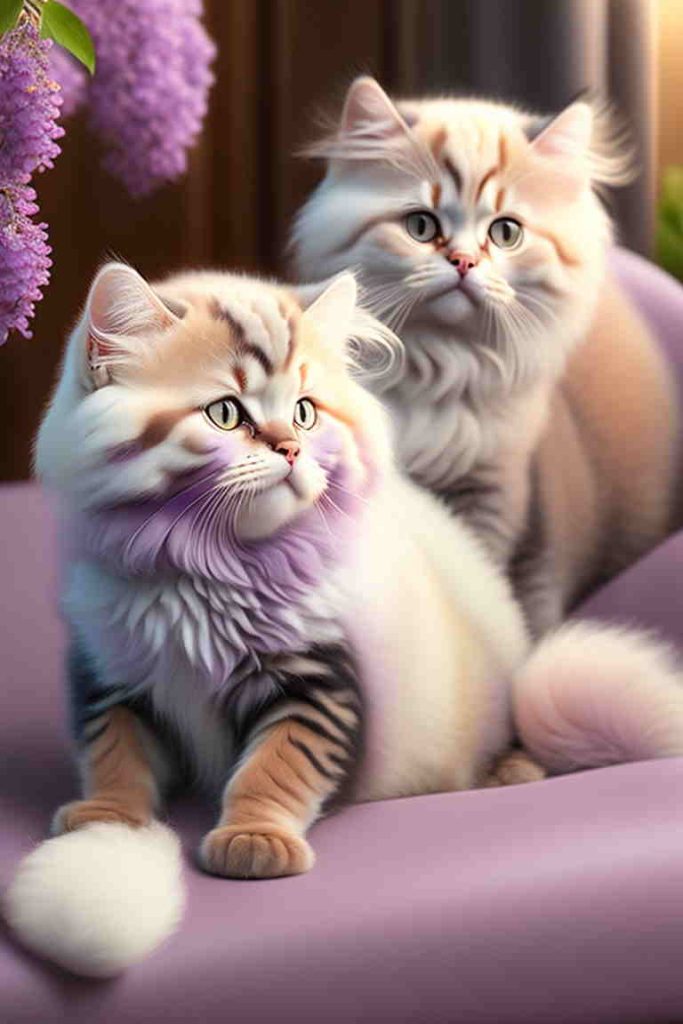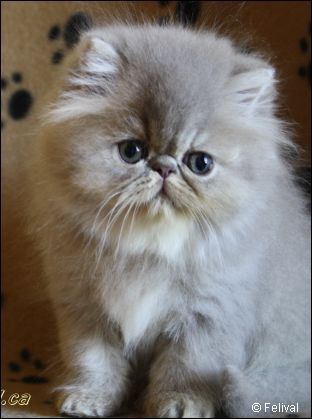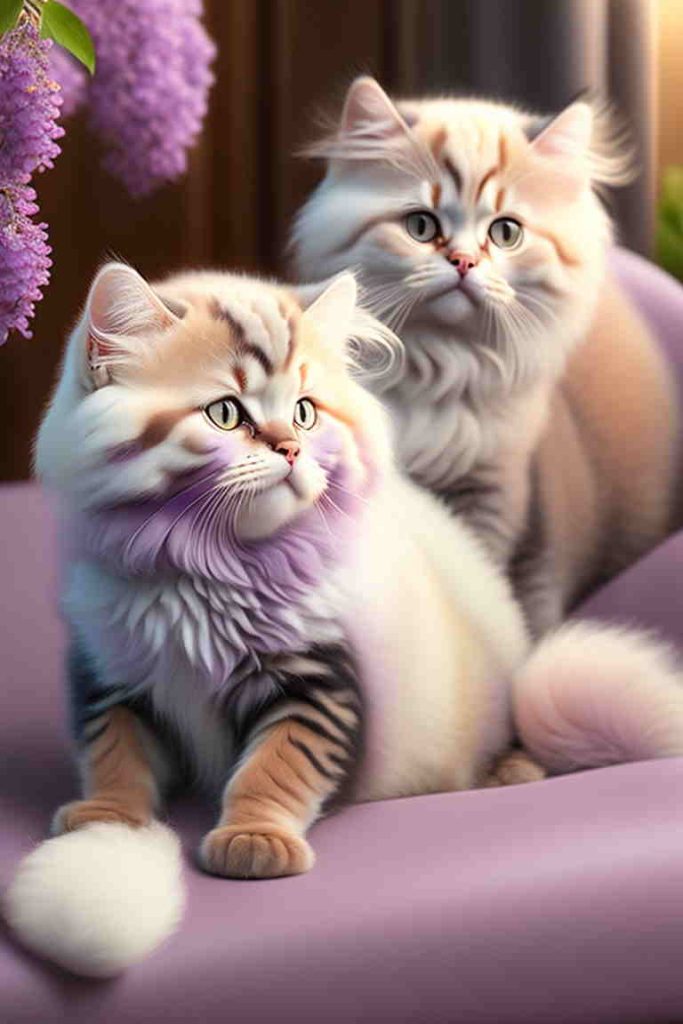If you’re looking to learn about the elegant and delicate nature of Lilac Persian cats, you’ve come to the right place. In this article, we’ll explore the mesmerizing charm and unique characteristics of these feline beauties. From their distinctive coat color to their gentle temperament, we’ll uncover the allure that makes Lilac Persians a favorite among cat lovers. So, grab a cup of tea, get cozy, and join us on this journey into the graceful world of Lilac Persians.

The Appearance of Lilac Persian Cats
Lilac Persian cats are known for their unique and captivating appearance. Let’s delve into their physical characteristics, temperament and personality, care and grooming needs, health concerns, exercise requirements, training considerations, feeding and nutrition requirements, breeding and reproduction, showing and exhibiting, as well as their historical fame and recognition.
Physical Characteristics
Lilac Persian cats possess a graceful and delicate beauty that sets them apart from other cat breeds. They have a medium to large-sized body, with a sturdy bone structure and a muscular build. Their coats are long, dense, and silky, providing them with an exquisite and luxurious appearance. These cats have a round and full face, with a short, broad nose and large, round eyes that are widely set apart. Their ears are small and rounded, emphasizing their adorable facial features.
Coat Color and Pattern
The standout feature of Lilac Persian cats is, undoubtedly, their unique coat color. The lilac color is a pale, muted lavender shade that is often described as soothing and ethereal. This soft and subtle hue is achieved through a dilution of the chocolate gene, resulting in a delicate and dreamy appearance. The lilac coat has a uniform coloration, without any markings or patterns, allowing the beauty of the color to take center stage.
Eye Color
Complementing their striking lilac coats, these cats have large, round eyes that come in various shades of blue. The vivid blue eyes of Lilac Persians can range from a light, icy blue to a deeper, more intense hue. This enchanting combination of lilac coat and blue eyes creates a captivating and mesmerizing look that is truly captivating.
Facial Features
The facial features of Lilac Persians are an integral part of their overall charm. With a round, doll-like face, these cats display a sweet and endearing expression that instantly captures your heart. Their broad, short nose adds to their adorable appearance. The combination of their round face, short nose, and expressive eyes create an irresistible and lovable look that is hard to resist.
Body Structure
Lilac Persian cats have a medium to large-sized body with a solid and well-built structure. Despite their sturdy physique, their movements are elegant and graceful. They possess a muscular build that adds to their overall strength and agility. The Lilac Persians have a thick, long, and luxurious coat that gives them a fuller appearance. With their dignified and regal posture, these cats exude an air of elegance and sophistication.
Temperament and Personality
Beneath their stunning exterior, Lilac Persian cats have personalities that are equally captivating. Here are some key traits that define their temperament:
Gentle and Loving
Lilac Persians are known for their gentle and loving nature. They are affectionate companions and enjoy being in the company of their human family members. These cats are often described as being exceptionally sweet and kind-hearted, always ready to offer their love and companionship. They have a calm and serene demeanor that makes them ideal pets for those seeking a loving and peaceful feline companion.
Reserved Nature
While Lilac Persians are undeniably affectionate, they also possess a reserved nature. These cats tend to be observant and prefer to take their time to warm up to new people or situations. They may initially appear shy or cautious, but with patience and understanding, they can develop deep attachments to their owners and become devoted companions.
Independent yet Affectionate
Despite their reserved nature, Lilac Persians still crave and enjoy human interaction. While they appreciate their alone time and can be independent, they thrive on affection and closeness with their human family. They may choose to curl up beside you or simply sit quietly in your presence, enjoying the soothing and comforting atmosphere you provide.
Adaptability
Lilac Persians are known for their adaptability. Whether you live in a spacious house or a small apartment, these cats can adjust well to various living environments. They are typically content and adaptable, making them excellent companions for individuals or families living in different settings.
Playfulness
While they may have a calm and serene demeanor, Lilac Persians also have a playful and mischievous side. These cats enjoy interactive playtime with their owners and can be easily entertained by toys, laser pointers, or feather wands. Incorporating play into their daily routine helps keep them mentally stimulated and physically active.
Care and Grooming of Lilac Persian Cats
To maintain the exquisite beauty of their coat and overall health, Lilac Persian cats require regular care and grooming. Here are some essential grooming practices to keep in mind:
Coat Maintenance
Lilac Persians have long, dense, and silky coats that require regular maintenance to prevent matting and tangles. Daily brushing with a grooming comb or brush specifically designed for long-haired cats is essential to keep their fur in pristine condition. This not only removes loose hair and prevents tangling but also helps distribute natural oils, keeping their coat shiny and healthy.
Bathing and Drying
While Lilac Persians are meticulous self-groomers, occasional bathing is still necessary to keep their coat free from dirt and oils. Using a cat-specific shampoo and warm water, gently wash their fur, taking care not to cause any stress or discomfort. After bathing, ensure thorough drying with a towel or low-heat blow-dryer to prevent moisture from becoming trapped near their skin, which can lead to skin irritation or infection.
Brushing and Combing
In addition to regular brushing, Lilac Persians also benefit from frequent combing to remove any remaining tangles or mats. A wide-toothed comb or a specialized grooming comb can be used to gently detangle their fur, ensuring a smooth and silky coat.
Nail Trimming
Regular nail trimming is an important part of Lilac Persian cat care. Long nails can cause discomfort and can also damage furniture or scratch their owners. Using a cat-specific nail trimmer, trim the pointed tips of the nails, taking care not to cut too close to the quick. If you are unsure about trimming your cat’s nails, seek guidance from a veterinarian or professional groomer.
Ear Cleaning
Lilac Persians, like many other breeds, require regular ear cleaning to prevent wax buildup or infection. Using a cat-friendly ear cleaner, moisten a cotton ball or pad and gently wipe the outer surface of their ears. Avoid inserting anything into the ear canal, as this can cause injury or discomfort. If you notice any redness, discharge, or a strong odor, consult a veterinarian for further evaluation.
Health and Potential Issues
Similar to other cat breeds, Lilac Persians may be prone to certain health issues. Understanding these potential concerns can help ensure early detection and proper care. Here are some health conditions commonly associated with Lilac Persians:
Breathing Problems
Due to their unique facial structure, Lilac Persians may experience breathing difficulties, such as snoring or snorting. This is primarily attributed to their shortened nasal passages and can be exacerbated by obesity. If you notice any changes in their breathing patterns or signs of respiratory distress, it is important to consult a veterinarian for guidance.
Eye Conditions
Lilac Persians are susceptible to various eye conditions, including genetic disorders like progressive retinal atrophy (PRA) and cherry eye. Regular eye examinations by a veterinarian can help detect any abnormalities or signs of discomfort. Maintaining good eye hygiene, such as gently wiping away any discharge, can also promote optimal eye health.
Dental Care
Dental health is crucial for Lilac Persians, as they are prone to periodontal disease and dental issues. Regular brushing using a cat-specific toothbrush and toothpaste, as well as routine dental check-ups, can help prevent dental problems and promote good oral hygiene.
Polycystic Kidney Disease (PKD)
Lilac Persians, like many other Persian cat variations, have a higher risk of developing polycystic kidney disease. PKD causes the formation of cysts in the kidneys and can lead to kidney dysfunction. Regular veterinary check-ups, including blood and urine tests, can help monitor kidney health and detect any signs of the disease early on.
Obesity and Weight Management
Lilac Persians are predisposed to weight gain and obesity if their diet and exercise are not carefully managed. Providing a balanced and portion-controlled diet, along with engaging them in regular play and exercise, can help prevent the onset of obesity and its associated health complications.

Lifestyle and Exercise Requirements
Lilac Persians have a moderate activity level and are generally well-suited for an indoor lifestyle. Here are some considerations for providing them with a healthy and stimulating environment:
Indoor Living
Due to their luxurious coats and delicate nature, Lilac Persians are best suited for indoor living. Indoor environments provide protection from potential dangers, such as extreme weather, predators, or accidents. Creating a safe and enriched indoor environment ensures their well-being and minimizes the risk of injury or illness.
Exercise and Play
While Lilac Persians may not be as active as some other breeds, they still require regular exercise to maintain a healthy weight and good muscle tone. Engaging them in daily play sessions with interactive toys or providing climbing structures can help fulfill their exercise needs. It is important to tailor the level of activity to their age, health, and individual preferences.
Toys and Enrichment
Providing a variety of toys, scratching posts, and interactive puzzles can keep Lilac Persians mentally stimulated and entertained. Toys that encourage chasing, pouncing, and exploring their surroundings are ideal for engaging their natural instincts. Experiment with different types of toys to find which ones capture their interest the most.
Creating a Safe Environment
Ensure that your home is free from potential hazards that could harm your Lilac Persian. Secure any toxic substances, including plants, chemicals, or cleaning products. Additionally, provide them with designated spaces, such as cozy cat beds or perches, where they can rest undisturbed.
Avoiding Stress and Anxiety
Lilac Persians, like any other cat, can experience stress and anxiety if their environment becomes loud, unpredictable, or overly stimulating. Providing them with a calm and peaceful living environment, free from sudden noises or disturbances, can help ensure their emotional well-being.
Training and Behavioral Considerations
Training and proper socialization are important for Lilac Persian cats to develop good behavior and manners. Here are some key considerations:
Litter Box Training
Lilac Persians are naturally clean animals and usually take to litter box training easily. Ensure that the litter box is kept clean and in a quiet, accessible location. If any issues arise, such as accidents outside the litter box or changes in litter box habits, consult a veterinarian to rule out any underlying health concerns.
Behavioral Issues
Lilac Persians are generally well-behaved cats, but they may occasionally exhibit behavioral issues. These can range from excessive scratching or meowing to aggression or anxiety. Consistent and positive reinforcement training techniques, alongside proper behavioral management, can help address these issues effectively.
Socialization with Other Pets
Proper socialization from an early age is important to ensure that Lilac Persians are comfortable and accepting of other pets or animals. Gradual introductions, supervised initial interactions, and positive reinforcement can help establish harmonious relationships between your Lilac Persian cat and other family pets.
Handling and Interaction
Lilac Persians are sensitive to handling and interaction, so it is important to approach them with gentleness and patience. Avoid rough or forceful handling, as this can cause them stress or discomfort. Allow them to initiate physical contact, and respect their cues if they prefer to be left alone.
Positive Reinforcement Techniques
Positive reinforcement training techniques, such as using treats or praise, can be highly effective when training Lilac Persians. These cats respond well to incentives and rewards, which helps reinforce desirable behaviors and motivates them to continue learning.

Feeding and Nutrition
Proper nutrition is essential for the overall health and well-being of Lilac Persian cats. Here are some important factors to consider when it comes to feeding and nutrition:
Choosing the Right Diet
Consulting with a veterinarian to determine the appropriate diet for your Lilac Persian is crucial. Consider factors such as their age, weight, activity level, and any specific dietary requirements or restrictions. High-quality cat food that is formulated to meet their nutritional needs is recommended.
Wet vs. Dry Food
Both wet and dry cat food can be part of a Lilac Persian’s diet. Wet food provides moisture and can be beneficial for maintaining hydration, while dry food helps promote dental health by reducing plaque and tartar buildup. Balancing the two types of food can provide a variety of textures and flavors for your cat.
Portion Control
Maintaining proper portion control is important to prevent overeating and obesity in Lilac Persians. Follow the feeding guidelines recommended by the manufacturer or consult with a veterinarian to ensure that you are providing the right amount of food based on their age, weight, and activity level.
Hydration Needs
Lilac Persians should have access to fresh water at all times to maintain proper hydration. Some cats prefer running water, so using a cat water fountain may encourage them to drink more. Monitoring their water intake is important, as a decrease in water consumption may indicate an underlying health issue.
Special Dietary Requirements
In certain situations, Lilac Persians may require special diets due to specific health conditions or dietary sensitivities. Consult with a veterinarian for guidance if your cat requires a specialized diet, such as grain-free or hypoallergenic options.
Breeding and Reproduction
Breeding Lilac Persian cats requires careful consideration and responsible breeding practices. Here are some important aspects to understand:
Breeding Lilac Persian Cats
Breeding Lilac Persians involves pairing two cats that carry the lilac gene. It is essential to thoroughly research the lineage, health history, and characteristics of potential breeding cats to ensure responsible and ethical breeding practices.
Pregnancy and Gestation
The average gestation period for cats is approximately 63-65 days. During pregnancy, it is crucial to provide the expectant mother with proper nutrition, regular veterinary check-ups, and a comfortable nesting area. Consult with a veterinarian for guidance on prenatal care and monitor the progress of the pregnancy closely.
Birth and Kitten Care
Lilac Persian cat births should ideally occur in a quiet and secure environment. Assist the mother cat during the delivery process, if necessary, and make sure the newborn kittens have access to warmth, proper nutrition, and the opportunity to nurse. Regular veterinary check-ups are essential to monitor the health and growth of the kittens.
Genetics and Inheritance
Understanding the basics of feline genetics is important before embarking on breeding Lilac Persians. Familiarize yourself with genetic inheritance patterns, gene mutations, and the potential for certain health conditions to be passed on to offspring. Responsible breeders prioritize minimizing genetic health risks by conducting proper health screenings and genetic testing.
Considerations for Responsible Breeding
Responsible breeding involves prioritizing the health and well-being of both the parent cats and the kittens. This includes ensuring proper socialization, a clean and safe environment, routine veterinary care, and finding suitable forever homes for the kittens. Responsible breeders adhere to ethical guidelines and place the welfare of the cats above financial gain.

Showing and Exhibiting Lilac Persian Cats
Lilac Persian cats have a charm that translates well to the show ring. Here are some key considerations for showing and exhibiting them:
Understanding Cat Shows
Cat shows are events where purebred cats are displayed and judged according to breed standards. It is an opportunity to showcase the unique qualities and beauty of Lilac Persians, as well as to connect with fellow feline enthusiasts. Attend cat shows as a spectator to familiarize yourself with the show environment and learn from experienced exhibitors.
Preparing Your Cat for Shows
Preparing your Lilac Persian for a show involves grooming, training, and general conditioning. Regular grooming sessions, including coat maintenance and nail trimming, are crucial to present your cat in prime condition. Getting your cat comfortable with being handled, examined, and transported is also important for a successful show experience.
Showmanship and Presentation
Presenting your Lilac Persian with confidence and skill is key to catching the judge’s attention. Develop showmanship techniques, such as effectively showcasing your cat’s best attributes, maintaining eye contact with the judge, and presenting them in the most flattering light. Practicing these skills at home can help build your cat’s confidence and enhance your show presentation.
Judging Criteria
Judging criteria for Lilac Persians focus on conforming to breed standards, which includes aspects such as coat color, eye color, body structure, facial features, and temperament. Understanding the breed standards provided by cat registries or breed associations can help prepare you for what judges will be looking for during the show.
Exhibitor Etiquette
Exhibitor etiquette is an important aspect of participating in cat shows. Respect the rules and regulations set by the show organizers, maintain good sportsmanship, and show respect towards fellow exhibitors and judges. Creating a positive and friendly atmosphere contributes to a successful and enjoyable show experience for all.
Famous Lilac Persian Cats in History
Throughout history, Lilac Persian cats have captivated the hearts of cat lovers worldwide. Here are some notable Lilac Persians and their contributions to the breed:
Notable Lilac Persian Cats
- “Chocolat” – A Lilac Persian that gained international fame for its stunning coat color and beauty.
- “Lady Lilac” – A Lilac Persian known for its exquisite features and elegant demeanor.
- “Prince Purrfect” – A Lilac Persian that made waves in the cat show circuit for its showmanship and exceptional temperament.
Their Contributions to the Breed
Notable Lilac Persians have played a significant role in advancing the breed and shaping the desired traits seen in Lilac Persians today. They have been exemplary examples of the breed standard, and their genetic contributions have helped perpetuate the lilac coat color and other sought-after traits.
Legacy and Influence
Famous Lilac Persians have left a lasting legacy in the cat fancy world. Their beauty and charm continue to influence breeders and enthusiasts, inspiring further breeding advancements and appreciation for the Lilac Persian breed.
Popularity and Recognition
While Lilac Persians may not be as widely recognized as some other Persian variations, their popularity has been steadily growing over the years. Their unique coat color and captivating appearance have gained them a dedicated following of admirers who appreciate their distinct beauty.
Celebrity and Royal Ownership
Lilac Persians have also found their way into the homes of various celebrities and members of royal families. Their regal presence and stunning features make them a popular choice for those seeking a glamorous and elegant feline companion.
Common Questions:
-
Are Lilac Persians hypoallergenic?
- No, Lilac Persians are not hypoallergenic. While they may produce fewer allergenic proteins than some other cat breeds, they still produce them and can trigger allergies in susceptible individuals.
-
How long do Lilac Persians usually live?
- On average, Lilac Persians have a lifespan of around 12 to 15 years. However, with proper care, nutrition, and regular veterinary check-ups, some Lilac Persians may live well into their late teens or even early twenties.
-
Do Lilac Persians require a lot of grooming?
- Yes, Lilac Persians require regular grooming to maintain the beauty of their coat. Daily brushing and periodic bathing are necessary to prevent matting, tangles, and to keep their fur clean and healthy.
-
Are Lilac Persians good with children and other pets?
- Lilac Persians can be great companions for children and other pets when properly socialized and introduced. They have a gentle temperament and tend to get along well with others with proper socialization and gradual introductions.
-
How often should I take my Lilac Persian to the veterinarian?
- Regular veterinary check-ups are essential to monitor the health and well-being of your Lilac Persian. It is recommended to schedule annual wellness exams, vaccinations, and dental check-ups. However, if you notice any unusual behavior, changes in appetite, or signs of illness, consult a veterinarian promptly.
-
Can Lilac Persians be trained like dogs?
- While Lilac Persians are intelligent, they may not respond to training commands in the same manner as dogs. However, they can still be trained using positive reinforcement techniques and can learn basic commands and behaviors. Patience, consistency, and rewards are key to successful training.
-
Are Lilac Persians good for apartment living?
- Yes, Lilac Persians can adapt well to apartment living. They are generally suited for indoor environments and do not require large amounts of space for exercise. However, providing vertical climbing structures, scratching posts, and interactive toys can help keep them mentally stimulated and physically active.
-
Do Lilac Persians shed a lot?
- Like many long-haired cats, Lilac Persians do shed, especially during seasonal changes. However, regular grooming and brushing can help minimize shedding and keep their coat in good condition.
-
Can Lilac Persians be left alone for long periods?
- Lilac Persians generally prefer the company of their human family members and do not appreciate being left alone for extended periods. They thrive in environments where they receive attention and companionship. If you need to be away for longer periods, consider providing interactive toys, scratching posts, or even a feline companion to help alleviate boredom and separation anxiety.
-
Are Lilac Persians prone to any specific health conditions?
- Lilac Persians can be more susceptible to certain health conditions, including breathing problems, eye conditions, dental issues, polycystic kidney disease (PKD), and obesity. Regular veterinary check-ups and proper care can help identify and manage these potential concerns effectively.

